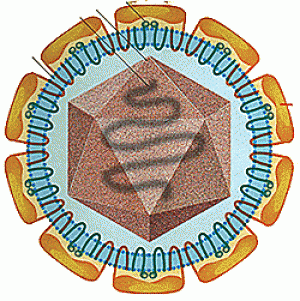
All iLive content is medically reviewed or fact checked to ensure as much factual accuracy as possible.
We have strict sourcing guidelines and only link to reputable media sites, academic research institutions and, whenever possible, medically peer reviewed studies. Note that the numbers in parentheses ([1], [2], etc.) are clickable links to these studies.
If you feel that any of our content is inaccurate, out-of-date, or otherwise questionable, please select it and press Ctrl + Enter.
Tick-borne encephalitis virus
Medical expert of the article
Last reviewed: 04.07.2025
 ">
">Tick-borne encephalitis is an infectious disease that is registered in Russia from Primorye to the western borders in the forest zone, i.e. habitats of carriers - ixodid ticks. As an independent nosological unit, it was identified in 1937 as a result of work in the Siberian taiga of a complex expedition headed by L. A. Zilber. The expedition included prominent virologists (M. P. Chumakov, V. D. Soloviev), clinicians, epidemiologists. Within 3 months, the viral nature of the disease was established, the characteristics of the virus and the main epidemiological patterns were determined, including natural focality, seasonality in connection with the activity of ticks. At the same time, the clinical features and pathomorphology of tick-borne encephalitis were described, some methods of prevention and therapy were developed. Further studies of this disease showed its prevalence not only in our country, but also abroad. Since the isolation of the tick-borne encephalitis virus, more than 500 of its strains have been discovered. According to the degree of pathogenicity for mice, the relationship to chicken embryo fibroblast tissue cultures and other indicators, they were divided into 3 groups. The third group includes weakly virulent strains.
According to the type of carrier, there are two main types of tick-borne encephalitis virus: persulcate, eastern (carrier Ixodes persukatus) and ricinus, western (carrier Ixodes ricinus). Study of the nucleotide sequence of genomic RNA in representatives of the eastern and western types of the virus revealed 86-96% homology. In recent years, a third type of the virus has been isolated from Rhipicephalus bursa ticks in Greece. According to the clinical course, there are two main variants of the disease: eastern, which is more severe, and western, which has a milder course.
In approximately 80% of cases, infection occurs through a tick bite and in 20% of cases, through the alimentary route when consuming raw goat, cow or sheep milk. Cases of laboratory infection are also known. Children of preschool and school age, as well as workers in geological parties, are most often affected.
The incubation period is from 1 to 30 days, most often 7-12 days from the moment the tick attaches. The onset of the disease is usually acute: chills, severe headache, temperature rise to 38-39 °C, nausea, sometimes vomiting, muscle pain, muscle twitching, meningeal signs develop.
There are three main forms of tick-borne encephalitis - febrile, meningeal and focal. The febrile form accounts for 30-50%, there are no signs of meningitis, the outcome is favorable, asthenia is observed infrequently. The meningeal form accounts for 40-60% of cases, is characterized by meningeal syndrome with changes in the cerebrospinal fluid, the fever can be two-wave.
Focal forms are observed less frequently (8-15%), the characteristic signs are meningeal symptoms and focal lesions of the nervous system of varying severity, accompanied by paralysis, loss of sensitivity and other neurological symptoms, damage to the brain stem, which leads to respiratory and cardiac dysfunction. Mortality is high, persistent complications remain after the disease.
Laboratory diagnostics are mainly carried out by virological and serological methods. The virus is isolated from blood, cerebrospinal fluid, urine, less often from nasopharyngeal swabs, feces and autopsy material when infecting cell cultures. The virus is typed in various variants of the reaction of biological neutralization of the virus. With the serological method, specific antibodies to the virus are detected in the RSK, neutralization, RTGA, immunosorbent reactions.
Treatment is symptomatic. To prevent the disease, a vaccination against tick-borne encephalitis in the form of a killed culture vaccine is used.

